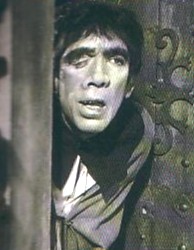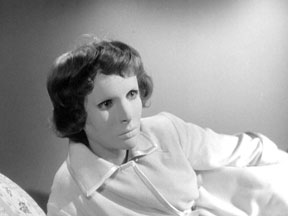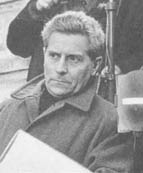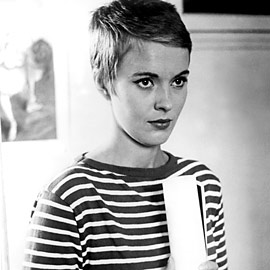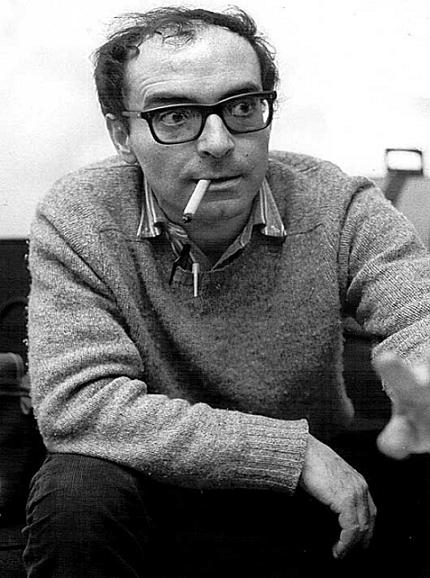 | The French New Wave |
|
Notre-dame de Paris |
des Yeux sans visage de Georges Franju |
Georges Franju |
|
Breathless (Jean Luc Godard), 1959 |
Jean Luc Godard |
Breathless (1959) |
During the German Occupation of France - poetic realism in the 1930.Claude Autant-Lara (1901-2000), Rene Clement (1913-1996), Jean Cocteau (1889-1963), Jacques Becker (1906-1960)
Robert Bresson (1907-1999) - film noir, literary adaptation.
Jacques Tati (1908-1982) -great comic talent in the postwar era as Max Linder, Charlie Chaplin, and Buster Keaton.
Another major figure was Max Ophuls.
Influence of the fifties Documentary Movement and Independent Production.By 1955, French commercial cinema was approaching stagnation because many filmmakers who had emerged during tjhe Occupation were firmly ensconced within the studio system or working on big-budget spectacles and international coproductions.The cinematic individualism of Bresson or Tati - personal expression. But the Major stylistic influences upon this next generation of filmmakers came from the French documentary movement of the 1950s, and from the films of independent directors working outside the studio system. Jean Gremillon, Roger Leenhard made short documentaries. Georges Franju - surrealism and german expressionism. Filmography http://www.fueradecampo.cl/filmografias/Franju.htm
Alan Resnais (b.1922), Chris Marker, who organize the radical cooperative SLON, for the production polemic work, the ethnographic filmmaker Jean Rouch - the apostle of cinema verite in 1960s ( he invented the term by translating Dziga Vertiv''s Kinopravda), Andres Verda, independent filmmakers and productions: Jean-Pierre Melville, Agnes Varda, Roger Vadim.
Франжю работал театральным художником и журналистом. Вместе с Анри Ланглуа основал один из первых киноклубов, а затем Французскую кинотеку (1936). С 1938 по 1945 г. был исполнительным секретарем Международной федерации киноархивов (ФИАФ). С 1945 по 1953 г. работал под руководством Жана Пенлеве генеральным секретарем Института научного кино. В течение многих лет снимал документальные фильмы (свой первый, еще любительский, фильм "Метро" снял вместе с А. Ланглуа в 1934 г.). В послевоенные годы Ф. становится одним из самых известных европейских документалистов. Мировую известность принесли режиссеру фильмы "Кровь животных" (1949, о парижской бойне), антивоенная лента "Отель Инвалидов" (1951), "Великий Мельес" (1952), "Месьеимадам Кюри" (1954), "Национальный Народный театр" (1956), "Нотр-Дам, собор Парижской Богоматери" (1957) и др. Его первый игровой полнометражный фильм "Головой об стену" (1958, по Эрве Базену), посвященный бесчеловечности французской психиатрии, вызвал широкую общественную дискуссию. Жан-Люк Годар сказал об этой картине: "Фильм безумца о безумцах, но фильм безумной красоты". В последующих лентах Ф. все определеннее проявляется склонность режиссера к психологической фантастике и патологии обыденной жизни ("Глаза без лица", 1959; "Жюдекс", 1963, поставленный в знак уважения к классическому одноименному фильму Луи Фейада). Значительную часть творчества Ф. составляют экранизации классических произведений французской литературы, в частности "Тереза Дескейру" (1962, по роману Франсуа Мориака), "Самозванец Тома" (1965, по Жану Кок-то), "Грех аббата Муре" (1970, по Эмилю Золя).
В середине 70-х гг. Франжю покидает кинематограф и возвращается в театр, одновременно работая на телевидении.
Фильмография:
"Отель Инвалидов" (Hotel des Invalides, док.), 1951; "Великий Мельес" (Le Grand Melies, док.), 1952; "Месье и мадам Кюри" (Monsieur et Madame Curie, док.), 1954; "Национальный Народный театр" (Theatre National popu-laire, док.) 1956; "Нотр-Дам, собор Парижской Богоматери" (Notre Dame — cathedrale de Paris, док.), 1957; "Головой об стену" (La tete contre les murs), 1958; "Глаза без лица" (Les yeux sans visage), 1959; "Полный свет на убийцу" (Pleins feuxsurl''assassin), 1960; "Тереза Дескейру" (Teresa Desqueroux), 1962; "Жюдекс" (Ju-dex), 1963; "Самозванец Тома" (Thomas l''imposteur), 1965; "Грех аббата Муре" (La Faute de l''abbe Mouret), 1970; "Пояс тени" (Laligned''ombre), 1971; "Красные ночи" (Nuits rouges), 1974.
The theoretical justification for the New Wave cinema - the film criti Alexandre Astruc, which would permit the cinema "to become a means of expression as supple and subtle as that of written language."Astruc''s notion was to break away from the tyranny of narrative. He wrote:"The fundament problem of the cinema is how to express thought. The creation of this language has preoccuped all the theoreticians and writters in the history of cinema, from Eisenstein down to the scriptwriters and adaptors of the sound cinema."Like Andre Bazin, Astric questioned the values of classic montage and was an apostle of the long take as Murnau. He founded an journal Cahiers du cinema (cinema notebooks) in 1951 for film lovers.
THE NEW WAVE FIRST FILMS:
it were dramatic shorts, shot in 16mm. Jacquer Rivette, Francois Truffaunt, Jean-Luc Godard, Claude Chabrol, Alain Resnais,Louis Malle, Eric Rohmer, Jacques Demy, Jacques Rivette, Agnes Varda, Jacques Demy."A classic film cannot translate the real rhythm of modern life. Modern life is fragmented, everyone feels that. Painting, as well as literature, bears witness to it, so why should the cinema not do so as well, instead of clinging to the traditional linear narrative."
The major technical characteristic of the New Wave include use os shaky, handheld 35mm camera shots, location shooting, natural lighting, improvised plot and dialogue, and direct sound recording on location with portable tape machines that were electronically synchronized with the camera. But the most important characteristic was its jagged, elliptical style of editing, which employed a high percentage of jump cuts within and mismatches between scenes in order to destroy the spatial and temporal continuity of the viewing experience. New Wave cinema is, in a sense, self-reflexive cinema, or metacinema - film about the process and nature of film itself.
Jean-Luc Godard''s Breathless (1960), with Jean-Paul Belmondo and Jean Seberg, was one of the major works of the French New Wave that was inspired by American film noir.
"It''s sad to fall asleep. It separates people. Even when you''re sleeping together, you''re all alone."
-- Patricia Franchini in Breathless
The story begins in Marseilles. Michel Poicard (Jean-Paul Belmondo), a young hoodlum, steals a car to go to Paris. He is pursued by a policeman on a motorcycle, whom he shoots dead with a gun he finds in the glove compartment. In Paris, Michel steals money from a friend to go off and find Patricia (Jean Seberg), an American girl who sells the Herald Tribune in the Champs-ElysЁ¦es. He is in love with her and wants to take her to Rome. This film gave Belmondo his first big role and Jean Seberg is exquisite under Godard''s direction
A Bout de Souffle, shot with bits and scraps of film on a very low budget, was the first official manifestation of the nouvelle vague, a style of cinema that emerged in France, in the period and was heavily inspired by what was being done in America. Godard threw away the rigidity of French conventions by using hand-held camera techniques and natural settings, giving his film a fluidity and a spontaneity in keeping with the life and character of his protagonist. The young Michel Poicard; dashing, daring, cynical and purile, is himself immersed in American culture (sporting his role-model Bogart''s hat and look). The film pays deliberate homage to the films of Preminger and other contemporary directors of the film noir genre.
The heroes banter, tell fibs and act silly. Yet the film is essentially about cowardliness, foreboding, betrayal and death on the prowl; on the difficulty of being who we pretend to be and even of knowing ourselves. In the void into which the youth of the times had fallen into, Godard could see only love to save them.
The love intrigue set aside, this is a great film about Paris and the spirit that reigned there at the time.
''''It''s life,'''' says the fugitive cop killer (Jean-Paul Belmondo) to his American girlfriend (Jean Seberg), who has just told him how much she hates informers (she will inform on him in the morning). ''''Informers inform. Burglars burgle. Murderers murder. Lovers love. Isn''t the Place de la Concorde beautiful?'''' Right there in Breathless, the breezy, biting, breathless fatalism that made Jean-Luc Godard''s debut feature a romantic slap in the face to filmgoers and filmmakers alike in 1960. This restored and digitally ''''revived'''' print of the French new-wave classic resharpens the edges of all those groundbreaking jump cuts and heightens the movie''s double-barreled sense of l''amour fou (Belmondo''s for Seberg, the director''s for old Hollywood movies), but the extras are scanty, tant pis. Critic-historian David Sterritt''s commentary track is good and reverent, and that''s the problem; in a perfect world, someone would have cajoled that shaggy old radical, Godard himself, into poetically deconstructing his own baby.
Alain Resnais, director of Hiroshima, Mon Amour (1959), on the need for audiovisual Impressionism
Resnais was the last of the old wave, or at the crest of the new
TIME & SPACE IN NEW WAVE CINEMA:
Godard, Varda, Truffaut, Marker
to Breathless
to La Jetee
THEORETICAL CONVICTION & MATERIAL CIRCUMSTANCES SHAPE THE FRENCH NEW WAVE
The New Wave is about a new relationship between fiction and reality.
Cahiers du Cinema: important journal edited by Andre Bazin
- group of critics-turned-filmmakers in mid-50s (Truffaut, Godard, Chabrol, Rivette, Rohmer)
- rejected commercial French cinema
- created style & aesthetics of independent, low-budget filmmaking out of necessity; they made do with what they had
- influenced by American movies, especially the genre masters like Hitchcock, Ford, and Hawks
- developed ideas about mise-en-scene and auteur theory; saw a dialectical relationship between the director''s unique vision (themes, style, motifs) and the genre''s conventions
- cinema about cinema
"LEFT BANK" filmmakers
(Resnais, Varda, Marker)
- same time period as Cahiers group, but their roots were in documentary film rather than criticism
- also cinematic modernists
- saw cinema in relation to other arts, especially literature
Characteristics of the New Wave:
- technological developments of television industry:
1) lightweight handheld cameras,
2) portable synchronous sound,
3) light-sensitive fast film stocks,
4) zoom lenses
new technologies allowed location shooting with small crews, improvisation during shooting, increased camera movement, natural light and sound
- self-conscious cinema
1) self-reflexive narratives, loose discursive plots, authorial intrusions, homages
2) camera and editing techniques such as iris shots, freeze frames, wipes, fast and slow motion
- unconventional editing
1) disrupts sense of time and space with flashbacks, jump cuts, asides
2) rejection of continuity editing of Classical Hollywood style in favor of lengthy takes, beginning scenes with close-ups instead of establishing shots
SELECTED FILMOGRAPHY OF THE NEW WAVE
Agnes Varda
La Pointe Courte (Varda, 1956)
Cleo from 5 to 7 (Varda, 1961)
Le Bonheur (Varda, 1965)
Daguerreotypes (Varda, 1977)
Francois Truffaut
The 400 Blows (Truffaut, 1959)
Shoot the Piano Player (Truffaut, 1960)
Jules et Jim (Truffaut, 1962)
Farenheit 451 (Truffaut, 1966)
Stolen Kisses (Truffaut, 1968)
Day for Night (Truffaut, 1973)
The Last Metro (Truffaut, 1981)
Jean-Luc Godard: Breathless
Contempt (Godard, 1963)
A Married Woman (Godard, 1964)
Masculine Feminine (Godard, 1966)
Weekend (Godard, 1967)
Chris Marker
La Jetee (Marker, 1962)
Eric Rohmer
La Boulangerie de Monceau (Rohmer, 1962)
Claude Chabrol
The Unfaithful Wife (Chabrol, 1968)
Other New Wave directors of note:
Louis Malle, Jacques Demy, Jacques Rivette
РЕЖИССЕРЫ
Жак Тати
Undercurrents: Neglected Works from the French New Wave
History & Analysis of Media Arts
